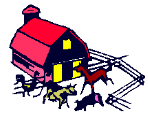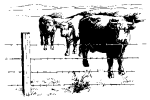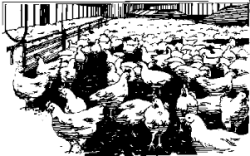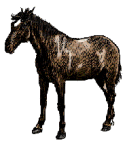

To send a message to an author, click on the author's name at the end of the article.
This Month in Ag Connection | Ag Connection - Other Issues Online
In December 2002 the US EPA published newly revised NPDES rules (National Pollution Discharge Elimination Systems provision of the Clean Water Act) for livestock production. It is estimated that the new rules will affect 15,000 livestock operations nation wide. Currently there are about 4,500 operations that have operating permits for the management of livestock manure treatment and with the new rule and an additional 11,000 farms may be required to apply for permits by 2006.

While the new rules are being used to set a national standard, states with NPDES permitting authority are being given flexibility in implementing the Concentrated Animal Feeding Operations (CAFO) rule. States will be the governing regulatory authority to issue permits and set the specific requirements for livestock operations. In Missouri the regulatory authority is the Department of Natural Resources (DNR), and thus operating permits for the handling, treatment and management of livestock manures will be obtained from DNR in compliance with the Missouri Code of State Regulations. States will have two years from the date of publication of the EPA rules to adjust state rules.
The significant changes that will affect Missouri Livestock operations include:

In the past, Missouri livestock operations were limited in the land application of manure to a maximum amount of 100 pounds of nitrogen per acre. Under new rules the land application of manure will be limited by the amount of both nitrogen and phosphorus present in the manure. In most cases this will result in phosphorus being the limiting factor in determining how much manure can be applied on a field. In order to meet this requirement farmers should start to plan now on strategies to reduce the amount of phosphorus in the livestock manure, increase the amount of land available for manure application, or adopt agronomic practices that will utilize more phosphorus. Currently DNR is working to develop rules governing land application limits for phosphorus.
Within the EPA rules, livestock operations are defined based on the number and type of animals being raised and eliminates the calculation for "animal units" that has been used in Missouri. Under the new rules "large" livestock operations, based on the number of animals, will be required to have a permit. While many of these numbers are the same as what the state of Missouri used to define a Class 1 livestock operation, livestock operations with swine under 55 pounds will be required to have a permit if they have more than 10,000 animals in that category as opposed to 15,000 previously. Conversely, broiler operations will not be required to obtain a permit until the size of the operation reaches 125,000 as opposed to 100,000 in the past and for laying chickens the new number is 60,000 as opposed to 30,000. The state of Missouri may choose to maintain the old number of broiler and laying operations. Any livestock operation may be required to obtain a permit if it is found to be polluting waters of the state.
The revised rules for livestock operations require all permitted facilities to have and follow a nutrient management plan. Nutrient management plans require information be collected and maintained on:
EPA will be encouraging all livestock operations to develop a CNMP; however, will not require a certified planner to develop or approve the nutrient management plan. It will be the responsibility of individual states to determine what specific requirements need to be included in nutrient management plans and the qualifications required for individuals developing these plans. Existing livestock operations will have until December 31, 2006 to comply with new nutrient management plan requirements. If an operation's permit expires prior to December 31, 2006, they will need to comply before a new permit is issued.
Other changes in the EPA rules that may have a smaller impact on Missouri livestock operations include designing manure containment systems with regard to rainfall events (EPA - 100 year, 24 hour storm event; current Missouri rules - the greater of 25 year, 24 hour storm event or "wettest year in 10"). Other requirements for livestock operations, such as water quality setbacks, are currently greater in Missouri than the new EPA rules in most cases.
For more information on EPA's new CAFO rules visit the websites http://cfpub.epa.gov/npdes/afo/cafofinalrule.cfm or the MU Commercial Agriculture website at http://agebb.missouri.edu/dairy/manure/
(Author: Darin Starr, Natural Resource Engineer)
This Month in Ag Connection | Ag Connection - Other Issues Online
The use of artificial insemination (AI) by seedstock producers has helped the beef industry capitalize on genetic improvement in economically desirable traits. Most commercial producers have not adopted AI systems due to the labor requirements of heat detection. Therefore, they have not been able to capture as much genetic improvement of the economically important traits.

To tighten calving seasons and reduce the time required for heat detection, researchers around the country have developed estrus synchronization protocols. There are simple protocols that can be used with natural service systems or more complex protocols to be used with AI systems. There are protocols that can be used with a timed AI system.
Missouri researchers have produced a brochure - MP735 - "Using MGA to Shorten the Beef Breeding Season". This publication is available through your local extension office and your regional livestock specialist. It is available on line at: http://extension.missouri.edu/publications/DisplayPub.aspx?P=MP735
(Author: Mark Stewart, Livestock Specialist)
This Month in Ag Connection | Ag Connection - Other Issues Online

Goat Day will be held at the Carver Farm at Lincoln University on April 5. Registration starts at 9:00 a.m. and programs continue until 3:30. A youth section is included.
For more information, contact Helen Swartz, Box 29, Lincoln University, Jefferson City, MO 65102-0029, phone (573) 681-5551, or email her at swartzh@lincolnu.edu
This Month in Ag Connection | Ag Connection - Other Issues Online

Three key principles of Biosecurity are: isolation, traffic control, and sanitation according to Dr. Joan S. Jeffrey, Extension Poultry Veterinarian, University of California-Davis. All three of these principles are hard to comply with if you are a small flock, backyard flock or hobby poultry owner. Biosecurity is still important to your operation. The Exotic Newcastle Disease outbreak in California, Nevada and as this is written, Arizona started in the southern California game fowl flocks.
Biosecurity is a practice designed to prevent the spread of disease onto your farm. It is accomplished by maintaining the facility in such a way that there is minimal traffic of biological organisms (viruses, bacteria, rodents, etc.) across its borders. Biosecurity is the cheapest, most effective means of disease control available. No disease prevention program will work without it.
Isolation refers to the confinement of animals within a controlled environment. A fence keeps your birds in, but it also keeps other animals out. Isolation also applies to the practice of separating birds by age group. In large poultry operations, all-in/all-out management styles allow simultaneous depopulation of facilities between flocks and allow time for periodic clean-up and disinfection to break the cycle of disease.
Traffic Control includes both the traffic onto your farm and the traffic patterns within the farm.
Sanitation addresses the disinfection of materials, people and equipment entering the farm and the cleanliness of the personnel on the farm.
Infectious diseases can be spread from farm to farm by:
The introduction of new birds and traffic pose the greatest risk to bird health. Properly managing these two factors should be a top priority.
In order to assess how much biosecurity is practical for your farm, look at these three factors:
New birds represent a great risk to biosecurity because their disease status is unknown. They may have an infection or be susceptible to an infection that is already present in carrier birds on your farm. All-in/all-out management isn't feasible for many breeding farms, farms raising exotic fowl or gamebirds. It is possible to maintain a separate pen or place to isolate and quarantine all new, in-coming stock from the resident population. At least two weeks of quarantine is suggested (four weeks is better) in isolation pens as far from the main flock as possible. Watch birds for any signs of illness. Diagnostic blood tests for infectious diseases can also be performed at this time.
Use only clean plastic coops for transfer of poultry. Wooden coops are difficult to clean and have been responsible for distributing poultry diseases over long distances.
Avoid putting new birds, including baby chicks, in contact with droppings, feathers, dust and debris left over from previous flocks. Some disease-causing organisms die quickly; others may survive for long periods.
Direct the flow of on-farm traffic from the youngest to the oldest birds. Direct the traffic flow from the resident to the isolation area. Establish a "clear zone" free of vegetation around buildings to discourage rodent and insect traffic into the buildings or pens. Use different pair of foot-covers in the isolation area and in the resident bird area to prevent the mechanical transfer of disease organisms on footwear. Footwear should be disinfected at each site. Disinfectant footbaths may help to decrease the dose of organisms on boots. But, because footbaths can be hard to correctly maintain it is a good idea to have a supply of cleanable rubber boots or strong-soled plastic boots for visitors.
Wash your hands after handling birds in isolation or birds of different groups. Disinfect waterers and feeders on a daily basis. Plan periodic clean-out, clean-up and disinfection of houses and equipment, at least once a year. Use this time to institute rodent and pest control procedures. Remember that drying and sunlight are very effective in killing many disease-causing organisms.
Dispose of dead birds promptly by rendering, burning, burying, composting or sending to a sanitary landfill.
(Author: Mark Stewart, Livestock Specialist)
This Month in Ag Connection | Ag Connection - Other Issues Online

The Missouri State Veterinarian's office reports they expect significant problems with West Nile Virus in horses again this year.
Horses that were vaccinated last year should receive a booster vaccine in March or early April. Due to how prevalent/virulent the virus is expected to be this summer, discuss with your vet the practicality of a second booster in late summer.
Horses that were not vaccinated last year should get their initial vaccination in March and follow-up with the second injection about four weeks later. Follow your veterinarian's recommendations on the time to wait between the two injections.
(Author: Mark Stewart, Livestock Specialist)
This Month in Ag Connection | Ag Connection - Other Issues Online
Publishing Information
Ag Connection is published monthly for Northeast and Central areas of Missouri producers and is supported by the University of Missouri Extension, the Missouri Agricultural Experiment Station, and the MU College of Agriculture, Food and Natural Resources. Managing Editor: Mary Sobba.